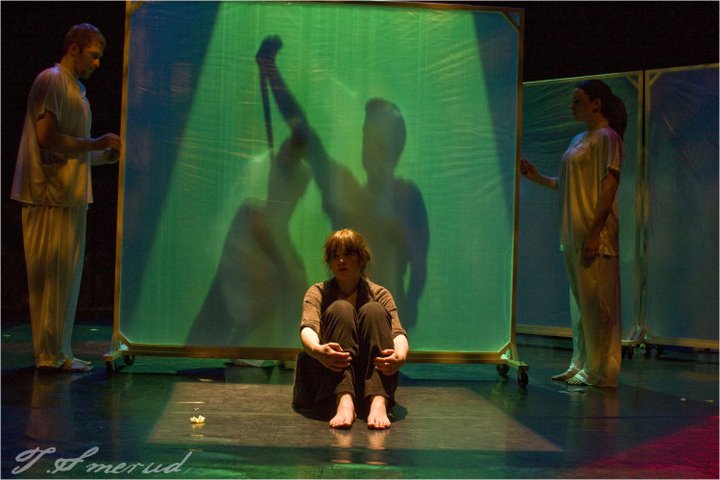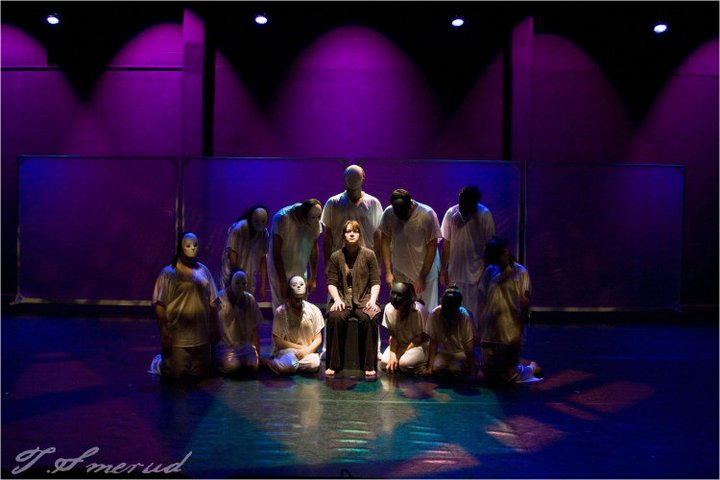-
Lighting DesignerJoe Holdman
Note: This is a re-submittal, with additional information, per the request of Tyrell Foster. I have already received a mug.
4.48 Psychosis, by Sarah Kane
Viterbo University Theatre, Feb 3-5, 2011
Directed by David Gardiner
Choreographed by Nikki Balsamo
Lighting Design: Joe Holdman
Scenic Design: Joe Holdman
Costume Design: Rachel Wahl
Rosco colors used: R3204, R08, R317, R21, R26, R34, R47, R60, R362, R67, R70, R73, R79, R388, R92, R99, R119
Rosco Gobos Used: ‘Squares’
Photos credit: Joe Holdman and Theresa Smerud
4.48 Psychosis, which was first performed in 2000, is a play that focuses on the unnamed central character’s struggles through mental illness, treatment, and eventually suicide. The play is written from a first-person perspective, using mostly stream-of-consciousness-style narrative. Some scenes are clear conversations between the central character and one or more doctors, and some are simply a list of numbers or a jumble of seemingly unrelated words and phrases.
The production was interpreted, discussed, choreographed, and performed by a collaborative company at Viterbo University in La Crosse, WI, in early 2011. The company included 12 dancer/actors, 2 designers, 2 stage managers, and 2 faculty director/choreographers.
Due to the lack of stage directions in the text, lighting was used to both light the dancer/actors and to convey a particular mood or emotion. I organized each scene by its emotional content, for example: some scenes depicted anger, some depicted depression, and some were neutral. Color was chosen based primarily on emotional content of the scene.
R08 and R362 were used as a front light system, but only in one or two scenes (not pictured). These scenes depicted the central character pulling herself out of her mental illness and returning to society, and the front lighting (hung at natural-looking 45 degree angles) was used to convey a sense of normalcy, of health.
Photo 1: R317 and R67 were used as side lighting for dancer/actors. I used R317 as key in the scenes depicting anger, and R67 as key in those depicting depression. R60 was used as a cool fill from the top, and to also draw focus on specific areas of the space.
Photo 2: This photo depicts the “color shards” system. The color shards represent hope, shards of color poking through an otherwise the gray and depressing world that the central character lives in. Throughout the piece, the character is striving to improve, to become healthy again. In the final scene, pictured here, the character commits suicide, and the shards go out one by one. The colors were chosen to match the costume designer’s color palette. Colors: R21, R26, R34, R47, R70, R73, R92, R99.
Photo 3: R388 was used as a backlight special for the central character, as per the director’s request. The text mentions a “shaft of light” several times, so a no-color square was used in the center of the stage, from the top. Rosco’s ‘Squares’ gobo was also used, no color, from the front, to light the dancer/actors but keep the dark and distorted look of the production.
Photo 4: R79 was used as back lighting. It allowed me to very subtly highlight certain areas of the black floor, and to create a silhouette effect on the dancer/actors. The color on the back wall was achieved using Ocean Optics SeaChangers, though not matched to any Rosco gel color.
Photo 5: Further use of shards, backlight, and gobo systems. Back wall color was chosen based on the emotional content of the scene.
Colors Used:



